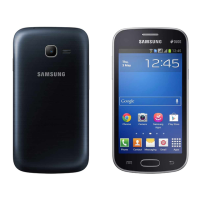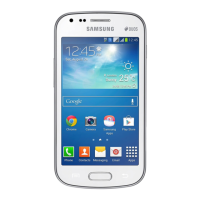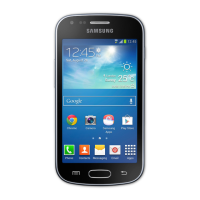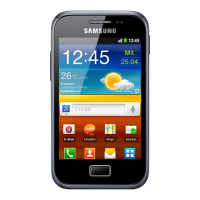Do you have a question about the Samsung GT-S7392 and is the answer not in the manual?
Overview of the phone's physical components and their locations.
Explains the functions of the power, menu, home, back, and volume buttons.
Lists the items included in the product box.
Step-by-step guide for inserting SIM/USIM cards and the battery.
Details on how to charge the device's battery using the charger or computer.
Guide on how to insert and use a memory card in the device.
Procedures for powering the device on and off, including first-time setup.
Methods to secure the device and prevent unauthorized access.
Various ways to set the device to silent or vibrate mode.
How to manage and switch between different SIM/USIM card network subscriptions.
Explains the meaning of various status icons displayed on the screen.
Guidelines and precautions for interacting with the device's touch screen.
Introduces basic touch gestures like tapping, dragging, flicking, and pinching.
How to use device motions for control, including screen rotation.
How to view and manage notifications from the status bar.
Introduction to the main screen for accessing applications and features.
How to add, move, or remove icons, widgets, and folders on the home screen.
How to change the background image for the home and lock screens.
General information on opening, closing, and managing applications.
Methods for inputting text, including keyboard and voice.
Steps to connect the device to a Wi-Fi network for internet access.
How to add Google and Samsung accounts for full device functionality.
Setting up screen locks like patterns, PINs, or passwords for security.
How to update the device's software via Samsung Kies or over the air.
Using the phone application to make and answer calls.
Actions available while on an active phone call.
Creating, editing, deleting, and searching for contacts.
Sending and receiving text (SMS) and multimedia (MMS) messages.
Setting up and managing email accounts and sending/reading emails.
Using Google Talk for instant messaging and chatting.
Connecting with others via Google's social network service.
Browsing the internet and searching for information using Google Chrome.
Connecting wirelessly to other devices for data exchange.
Steps to establish a Bluetooth connection with new devices.
Using the device's camera to capture photos and videos.
How to take pictures, including using scene modes and shooting modes.
How to record videos, including changing recording modes and zooming.
Viewing and managing photos and videos taken with the device.
Playing video files stored on the device.
Watching videos from the YouTube platform on the device.
Listening to FM radio broadcasts using the device.
Downloading and purchasing applications and games from the Google Play Store.
Accessing and downloading dedicated Samsung applications.
Reading and downloading digital book files.
Watching, downloading, and renting movies and TV shows.
Recording and managing notes and important information.
Managing events, appointments, and syncing with Google Calendar.
Saving and sharing files via the Dropbox cloud storage service.
Setting alarms and using the device as a desk clock.
Performing simple and complex calculations.
Recording and playing voice memos.
Searching the internet and device content, including Google Now.
Accessing and managing all files stored on the device.
Pinpointing locations, searching for places, and getting directions.
Step-by-step instructions for obtaining travel directions.
Searching for nearby points of interest like restaurants and banks.
Finding routes and navigating to destinations.
Connecting to Wi-Fi networks and managing network settings.
Managing Bluetooth connections and settings.
Tracking and managing mobile data consumption.
Configuring cellular network settings like data and roaming.
Customizing settings for SIM/USIM cards, including voice and data preferences.
Adjusting volume levels, ringtones, and vibration settings.
Customizing screen brightness, wallpaper, font style, and timeout.
Viewing device and memory card storage information.
Viewing and managing installed applications on the device.
Managing permissions for location data collection and GPS usage.
Configuring screen lock features and options for security.
Managing device security settings, including SIM lock and unknown sources.
Changing display language and configuring text input methods.
Backing up data and resetting device settings to factory defaults.
Special features for users with physical disabilities.
Advanced settings for application development and debugging.
Solutions for prompts requiring password, PIN, or PUK codes.
Troubleshooting steps for network connectivity issues and error messages.
Steps to resolve issues when the device fails to power on.
Solutions for unresponsive or slow touch screen performance.
Troubleshooting steps for device freezes, hangs, or fatal errors.
Steps to resolve issues with failed outgoing or incoming calls.
Solutions for microphone issues during calls.
Troubleshooting intermittent network disconnections and poor audio quality.
Solutions for issues where the device is not charging correctly.
Troubleshooting tips for camera application errors.
Solutions for issues playing or opening media files.
Troubleshooting steps when Bluetooth devices cannot be found or connected.
Solutions for problems connecting the device to a computer via USB.
Troubleshooting GPS location issues and alternative methods.
Importance of backups and Samsung's responsibility for lost data.
Overview of the phone's physical components and their locations.
Explains the functions of the power, menu, home, back, and volume buttons.
Lists the items included in the product box.
Step-by-step guide for inserting SIM/USIM cards and the battery.
Details on how to charge the device's battery using the charger or computer.
Guide on how to insert and use a memory card in the device.
Procedures for powering the device on and off, including first-time setup.
Methods to secure the device and prevent unauthorized access.
Various ways to set the device to silent or vibrate mode.
How to manage and switch between different SIM/USIM card network subscriptions.
Explains the meaning of various status icons displayed on the screen.
Guidelines and precautions for interacting with the device's touch screen.
Introduces basic touch gestures like tapping, dragging, flicking, and pinching.
How to use device motions for control, including screen rotation.
How to view and manage notifications from the status bar.
Introduction to the main screen for accessing applications and features.
How to add, move, or remove icons, widgets, and folders on the home screen.
How to change the background image for the home and lock screens.
General information on opening, closing, and managing applications.
Methods for inputting text, including keyboard and voice.
Steps to connect the device to a Wi-Fi network for internet access.
How to add Google and Samsung accounts for full device functionality.
Setting up screen locks like patterns, PINs, or passwords for security.
How to update the device's software via Samsung Kies or over the air.
Using the phone application to make and answer calls.
Actions available while on an active phone call.
Creating, editing, deleting, and searching for contacts.
Sending and receiving text (SMS) and multimedia (MMS) messages.
Setting up and managing email accounts and sending/reading emails.
Using Google Talk for instant messaging and chatting.
Connecting with others via Google's social network service.
Browsing the internet and searching for information using Google Chrome.
Connecting wirelessly to other devices for data exchange.
Steps to establish a Bluetooth connection with new devices.
Using the device's camera to capture photos and videos.
How to take pictures, including using scene modes and shooting modes.
How to record videos, including changing recording modes and zooming.
Viewing and managing photos and videos taken with the device.
Playing video files stored on the device.
Watching videos from the YouTube platform on the device.
Listening to FM radio broadcasts using the device.
Downloading and purchasing applications and games from the Google Play Store.
Accessing and downloading dedicated Samsung applications.
Reading and downloading digital book files.
Watching, downloading, and renting movies and TV shows.
Recording and managing notes and important information.
Managing events, appointments, and syncing with Google Calendar.
Saving and sharing files via the Dropbox cloud storage service.
Setting alarms and using the device as a desk clock.
Performing simple and complex calculations.
Recording and playing voice memos.
Searching the internet and device content, including Google Now.
Accessing and managing all files stored on the device.
Pinpointing locations, searching for places, and getting directions.
Step-by-step instructions for obtaining travel directions.
Searching for nearby points of interest like restaurants and banks.
Finding routes and navigating to destinations.
Connecting to Wi-Fi networks and managing network settings.
Managing Bluetooth connections and settings.
Tracking and managing mobile data consumption.
Configuring cellular network settings like data and roaming.
Customizing settings for SIM/USIM cards, including voice and data preferences.
Adjusting volume levels, ringtones, and vibration settings.
Customizing screen brightness, wallpaper, font style, and timeout.
Viewing device and memory card storage information.
Viewing and managing installed applications on the device.
Managing permissions for location data collection and GPS usage.
Configuring screen lock features and options for security.
Managing device security settings, including SIM lock and unknown sources.
Changing display language and configuring text input methods.
Backing up data and resetting device settings to factory defaults.
Special features for users with physical disabilities.
Advanced settings for application development and debugging.
Solutions for prompts requiring password, PIN, or PUK codes.
Troubleshooting steps for network connectivity issues and error messages.
Steps to resolve issues when the device fails to power on.
Solutions for unresponsive or slow touch screen performance.
Troubleshooting steps for device freezes, hangs, or fatal errors.
Steps to resolve issues with failed outgoing or incoming calls.
Solutions for microphone issues during calls.
Troubleshooting intermittent network disconnections and poor audio quality.
Solutions for issues where the device is not charging correctly.
Troubleshooting tips for camera application errors.
Solutions for issues playing or opening media files.
Troubleshooting steps when Bluetooth devices cannot be found or connected.
Solutions for problems connecting the device to a computer via USB.
Troubleshooting GPS location issues and alternative methods.
Importance of backups and Samsung's responsibility for lost data.
| Model | GT-S7392 |
|---|---|
| Status | Discontinued |
| Dimensions | 121.5 x 63.1 x 10.8 mm (4.78 x 2.48 x 0.43 in) |
| SIM | Dual SIM (Mini-SIM, dual stand-by) |
| Display Type | TFT capacitive touchscreen, 256K colors |
| Display Resolution | 480 x 800 pixels (~233 ppi pixel density) |
| OS | Android 4.1.2 (Jelly Bean) |
| GPU | Broadcom VideoCore IV |
| Card Slot | microSD, up to 32 GB |
| Main Camera | 3.15 MP |
| Selfie Camera | No |
| WLAN | Wi-Fi 802.11 b/g/n, Wi-Fi Direct, hotspot |
| Bluetooth | 4.0, A2DP |
| GPS | Yes, with A-GPS |
| USB | microUSB 2.0 |
| Sensors | Accelerometer, proximity |
| Battery Type | Li-Ion 1500 mAh, removable |
| Display Size | 4.0 inches |
| Internal Memory | 4GB |
| Radio | FM radio |
| Colors | White, Black |











